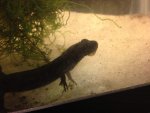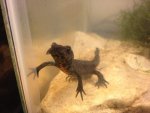I've noticed dropping jowls in my newts for years. It seems common amongst stout bodied newts. Most of my adult or subadult T. karelinii have had dropping jowls at some point in their lives. For me they developed the larger jowls during their 1st year as subadults when the temperatures start to drop. It seems the smaller ones in the groups develop the larger jowls that can last for 1-2 years.
Species I've had or have with enlarged jowls are T. marmoratus, T. karelinii, T artzeni, T. dobrogicus, C. orientalis, and maybe a couple others.
All 3 of my Triturus artzeni males had them their 1st year. The smallest out of the group still has his large jowls. I guess in some biological way he developed the jowls to compete with the larger males, assuming the jowls help the newt to eat more effectively.




